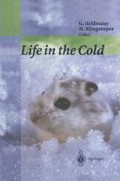Abstract
For many years, investigators have questioned whether circadian rhythms continue to be expressed in mammals that hibernate when body temperature (Tb) is low. We have examined the circadian rhythm of Tb in marmots (Marmota flaviventris) under laboratory and field conditions during the winter hibernation period. Using temperature data loggers that were implanted in animals, Tb measurements were continuously recorded for up 2 years. We found that animals in the laboratory continued to manifest a circadian rhythm of Tb prior to hibernating, during deep hibernation, and after arousal from hibernation. Whereas animals in the field had robust circadian rhythms of Tb prior to hibernation, we were not able to detect a Tb rhythm during deep hibernation. We did find a diurnal rhythm of Tb once field animals had aroused for the last time in the spring and came above ground. In fact, we were able to determine when field animals must have been exposed to light, because they were entrained to the daily light-dark cycle. Our results suggest that in the laboratory, animals may be picking up cues and their Tb rhythm free-runs with a period close to 24hr. The fact that we found no circadian rhythm of Tb in our field animals that were in constant dark and very quiet conditions suggests that the circadian pacemaker is uncoupled from the Tb rhythm or is so damped that the output cannot be detected. We believe that circadian system is nonfunctional during deep hibernation under natural conditions.
Access this chapter
Tax calculation will be finalised at checkout
Purchases are for personal use only
Preview
Unable to display preview. Download preview PDF.
References
Canguilhem B, Malan A, Masson-Pevet M, Nobelis P, Kirsch R, Pevet P, Le Minor J (1994) Search for rhythmicity during hibernation in the European hamster. J. Comp. Physiol B 163: 690–698.
Dorrscheidt GJ, Beck L.(1975) Advanced methods for evaluating characteristic parameters of circadian rhythms. J. Math Biol. 2:107–121
Grahn DA, Miller JD, Houng VS, Heller HC.(1994) Persistence of circadian rhythmicity in hibernating ground squirrels. Am. J. Physiol. 266 (Regulatory Integrative Comp. Physiol. 35): R1251–R1258.
Kristofferson R, Soivio A (1964) Hibernation of the hedgehog (Erinaceus europaeus L.). The periodicity of hibernation of undisturbed animals during the winter in a constant ambient temperature. Ann Acad. Sci. Fenn. Ser A. IV 76:1–11.
Kilduff T, Radeke CD, Heller HC. (1985) Neural activity during mammalian hibernation. In Heller HC, Musacchia XJ, Wang LCH, (eds) Living in the Cold: Physiological and Biochemical Adaptations. Elsevier. New York. pp.215–225.
Kortner G, Song X, Geiser F (1998) Rhythmicity of torpor in a marsupial hibernator, the mountain pygmy-possum (Bu rramys parvus), under natural and laboratory conditions. J Comp. Physiol. B 168: 631–638.
Lyman CP, Willis JS, Malan A, Wang LCH (1982) Hibernation and Torpor in Mammals and Birds. Academic Press, New York, N.Y.
Menaker M (1961) The free-running period of the bat clock: seasonal variations at low body temperature. J. Cell Comp. Physiol. 57:81–86.
Miller JD, Cao VH, Heller HC (1994) Temperature effects on neuronal activity in suprachiasmatic nuclei of hibernators and nonhibernators. Am. J. Physiol. 266 (Regulatory, Integrative, and Comp. Physiol. 35): R1259–R1266.
Pohl H (1987) Circadian pacemaker does not arrest in deep hibernation. Evidence for desynchronization from the light cycle. Experientia Basel 43:293–294.
Strumwasser F, Schlechte FR, Streeter J (1967) The internal rhythms of hibernators. In Fisher KC, Dawe AR, Lyman CP, Schonbaum E, South FE, (eds) Mammalian Hibernation III. Oliver and Boyd Edinburgh, UK pp. 110–139
Thomas DW (1993) Lack of evidence for a biological alarm clock in bats (Myotis spp) hibernating under natural conditions. Can. J. Zool. 71: 1–3
Twente JW, Twente JA. (1965) Regulation of hibernating periods by temperature. Proc. Natl. Acad. Sci. USA 54:1058–1061.
Wabmer T, Wollnik F (1997) Timing of torpor bouts during hibernation in European hamsters (Cricetus cricetus L.) J. Comp. Physiol. B 167:270–279.
Wang LCH (1979) Time patterns and metabolic rates of natural torpor in the Richardson’s ground squirrel. Can. J. Zool. 57: 149–155.
Wollnik F, Schmidt B. (1995) Seasonal and daily rhythms of body temperature in the European hamster (Cricetus cricetus) under semi-natural conditions. J. Comp. Physiol. B 165: 171–182.
Whittaker, E. and Robinson G. The calculus of observations. London: Blackie and Son 1924. (4th edition, Dover publications 1967).
Author information
Authors and Affiliations
Editor information
Editors and Affiliations
Rights and permissions
Copyright information
© 2000 Springer-Verlag Berlin Heidelberg
About this paper
Cite this paper
Florant, G.L., Hill, V., Ogilvie, M.D. (2000). Circadian Rhythms of Body Temperature in Laboratory and Field Marmots (Marmota flaviventris). In: Heldmaier, G., Klingenspor, M. (eds) Life in the Cold. Springer, Berlin, Heidelberg. https://doi.org/10.1007/978-3-662-04162-8_24
Download citation
DOI: https://doi.org/10.1007/978-3-662-04162-8_24
Publisher Name: Springer, Berlin, Heidelberg
Print ISBN: 978-3-642-08682-3
Online ISBN: 978-3-662-04162-8
eBook Packages: Springer Book Archive

